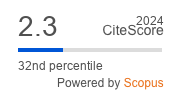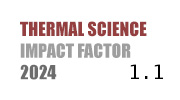ABSTRACT
Gasoline presents considerable safety hazards during the storage and transportation processes. In the study, the effects of three typical inert gases of carbon dioxide (CO2), nitrogen (N2), and argon (Ar) on the cloud explosion of gasoline were studied using a 20 L spherical explosion vessel. The experimental results showed that the ultimate volume fractions (nU) of the inert gases required to completely suppress gasoline cloud explosion were 86 vol. %, 88 vol. %, and 92 vol. %, respectively. As the volume fraction (n) of inert gases increased, the maximum explosion pressure (ΔPmax), the maximum explosion pressure rise rate ((dP/dt)max), the maximum average temperature (Tam), and the explosion risk index (KG) of the gasoline cloud explosion all exhibited a downward trend, while the combustion duration (td) increased. CO2 primarily inhibited the initial stage of the gasoline cloud explosion reaction, reducing the oxidation rate by interfering with elementary reactions through both physical (heat absorption) and chemical (reaction inhibition) ways. While N2 and Ar mainly weakened the second stage of explosion, primarily through heat absorption and dilution effects. The research conclusions could offer theoretical guidance for the safe storage and transportation of gasoline by making explosion protection measures.
KEYWORDS
PAPER SUBMITTED: 2025-05-14
PAPER REVISED: 2025-07-07
PAPER ACCEPTED: 2025-07-11
PUBLISHED ONLINE: 2025-08-02
- Zahlanieh SE, Jean A, Vignes A, et al (2023) A sneak peek into the phenomenology of fuel mist explosions: The key role of vapor fractions. J. Loss Prev. Process Ind 83: 105029. doi.org/10.1016/j.jlp.2023.105029
- Cai P, Liu ZY, LiM Z, et al (2022) Experimental study of effect of equivalence ratio and initial turbulence on the explosion characteristics of LPG/DME clean blended fuel. Energy 250: 123858. doi.org/10.1016/j.energy.2022.123858
- Song YF, Zhang Q (2021) Explosion effect of vapor-liquid two-phase n-heptane at various initial temperatures. Process Saf. Environ. Protect 145: 303-311. doi.org/10.1016/j.psep.2020.08.021
- Mitu M, Brandes E, Hirsch W (2016) Effects of initial temperature and pressure on explosion characteristics of hydrocarbon-air mixtures. J. Loss Prev. Process Ind. 43: 42-52. doi.org/10.1016/j.jlp.2016.04.008
- Yang P, Wang T, Sheng YH, et al (2024) Recent advances in hydrogen process safety: Deflagration behaviors and explosion mitigation strategies. Process Saf. Environ. Protect 188: 303-316. doi.org/10.1016/j.psep.2024.05.111
- Song SX, Wang C, Qiao BY, et al (2024) Explosion damage effects of aviation kerosene storage tank under strong ignition. Def. Technol 37: 27-38. doi.org/10.1016/j.dt.2023.12.009
- Li SZ, Cheng YF, Wang R, et al (2023) Suppression effects and mechanisms of three typical solid suppressants on titanium hydride dust explosions. Process Saf. Environ. Protect 177: 688-698. doi.org/10.1016/j.psep.2023.07.039
- Yang J, Yu Y, Li YH, et al (2019) Inerting effects of ammonium polyphosphate on explosion characteristics of polypropylene dust. Process Saf. Environ. Protect 130: 221-230. doi.org/10.1016/j.psep.2019.08.015
- Liu ZQ, Zhong XX, Zhang Q, et al (2020) Experimental study on using water mist containing potassium compounds to suppress methane/air explosions. J. Hazard. Mater 394: 122561. doi.org/10.1016/j.jhazmat.2020.122561
- Zhang SY, Wen XP, Guo ZD, et al (2023) Effect of N2 and CO2 on explosion behavior of hydrogen-air mixtures in non-premixed state. Fire Saf. J 138: 103790. doi.org/10.1016/j.firesaf.2023.103790
- Chelliah HK, Wanigarathne PC, Lentati AM, et al (2003) Effect of sodium bicarbonate particle size on the extinction condition of non-premixed counterflow flames. Combust. Flame 134: 261-272. doi.org/10.1016/S0010-2180(03)00092-0
- Amyotte PR (2006) Solid inertants and their use in dust explosion prevention and mitigation. J. Loss Prev. Process Ind 19: 161-163. doi.org/10.1016/j.jlp.2005.05.008
- Liang XQ, Zhou XY, Lu X, et al (2024) Investigation on slag resource utilization: KHCO3/modified slag composite powder applied to methane/air explosion suppression. Powder Technol 41: 119814. doi.org/10.1016/j.powtec.2024.119814
- Mu XM, Cong HY, Shao ZY. et al (2023) Experimental and theoretical research on the inhibition performance of ethanol gasoline/air explosion by C6F12O. J. Loss Prev. Process Ind 83: 105088. doi.org/10.1016/j.jlp.2023.105088
- Zhang C, Bai CH, Ren JF, et al (2022) The promotion of nitromethane on solid--liquid fuel/air mixtures explosion characteristics under different ambient conditions. Fuel 322: 124190. doi.org/10.1016/j.fuel.2022.124190
- Abdelkhalik A, Askar E, Markus D, et al (2016) Explosion regions of propane, isopropanol, acetone, and methyl acetate/inert gas/air mixtures. J. Loss Prev. Process Ind 43: 669-675. doi.org/10.1016/j.jlp.2016.04.001
- Mitu M, Brandes E, Hirsch W (2018) Mitigation effects on the explosion safety characteristic data of ethanol/air mixtures in closed vessel. Process Saf. Environ. Protect 117: 190-199. doi.org/10.1016/j.psep.2018.04.024
- Mabrouk E, Mourad B (2010) Efficiency of natural and acid-activated clays in the removal of Pb(II) from aqueous solutions. J. Hazard. Mater 178: 1-3. doi.org/10.1016/j.jhazmat.2010.02.004
- Wang H, Wu F, Pan XH, et al (2023) Spray and explosion characteristics of methanol and methanol-benzene blends near azeotrope formation: Effects of temperature, concentration, and benzene content. J. Loss Prev. Process Ind 83: 105079. doi.org/10.1016/j.jlp.2023.105079
- Zhang B, Shen XB, Pang L (2015) Effects of argon/nitrogen dilution on explosion and combustion characteristics of dimethyl ether--air mixtures. Fuel 159: 646-652. doi.org/10.1016/j.fuel.2015.07.019
- Zhang B, Ng HD (2016) An experimental investigation of the explosion characteristics of dimethyl ether-air mixtures. Energy 107: 1-8. doi.org/10.1016/j.energy.2016.03.125
- Mukhtar M, Hagos FY, Aziz ARR, et al (2022) Combustion characteristics of tri-fuel (diesel-ethanol-biodiesel) emulsion fuels in CI engine with micro-explosion phenomenon attributes. Fuel 312: 122933. doi.org/10.1016/j.fuel.2021.122933
- Amyotte P R, Pegg M J, Khan F I. (2009) Explosion characteristics of coal dust-liquid hybrid mixtures: Effects of liquid content and volatility[J]. J. Loss Prev. Process Ind 22: 484-491
- Hu ZL, Zhang YJ, Ai ZY, et al (2024) Hydrogen doping control method for gasoline engine acceleration transient air-fuel ratio. Heliyon 10: e30865. doi.org/10.1016/j.heliyon.2024.e30865
- Guo Y, Ren K, Huang W, et al (2022) An alternative explosion criterion of combustible dusts based on combustion duration time: applications for minimum explosion concentration and limiting oxygen concentration. Powder Technol 409:117851. doi.org/10.1016/j.powtec.2022.117851
- Wu D, Krietsch A, Schmidt M, et al (2022) Effect of oxygen concentration, inert gas and CH4/H2 addition on the minimum ignition energy of coal dusts. J. Loss Prev. Process Ind 77: 104772. doi.org/10.1016/j.jlp.2022.104772
- Li W F, Liu Z C, Wang Z S, et al. 2015. Experimental and theoretical analysis of effects of atomic, diatomic and polyatomic inert gases in air and EGR on mixture properties, combustion, thermal efficiency and NOx emissions of a pilot-ignited NG engine. Energy Conversion and Management. 105: 1082-1095
- Wang C, Song S X, Qiao B Y, et al. 2024. Explosion behaviors of aviation kerosene in a 20 L spherical vessel. Aerospace Science and Technology. 2024: 109308
- Lu YW, Fan RJ, Wang ZR, et al (2024) The influence of hydrogen concentration on the characteristic of explosion venting: Explosion pressure, venting flame and flow field microstructure. Energy 293: 130562. doi.org/10.1016/j.energy.2024.130562
- Cao XY, Zhou JY, Zhou X, et al (2024) Experimental research on the synergy effect of resistance/inhibition on the syngas explosion. Fuel 363: 130995. doi.org/10.1016/j.fuel.2024.130995
- Qu J, Zhou T, Luo ZM, et al (2024) Research on explosion hazard and prevention of ultrafine aluminium powder based on orthogonal matrix analysis. Process Saf. Environ. Protect 186: 910-920. doi.org/10.1016/j.psep.2024.04.067
- Linteris, G. T., et al. (2008). Chemical inhibition of methane-air flames by fire suppressants. Combustion and Flame, 155(1-2), 227--239.和和Westbrook, C. K., Pitz, W. J., & Curran, H. J. (2006). Chemical kinetics of gasoline ignition. Progress in Energy and Combustion Science, 32(3), 283--357
- Chatrathi, K., & Going, J. E. (2001). Flammability limits of combustible gases and vapors in inert atmospheres. Journal of Loss Prevention in the Process Industries, 14(6), 463--474
- Wang ZH, Cheng YF, Mogi T, et al (2022) Flame structures and particle-combustion mechanisms in nano and micron titanium dust explosions. J. Loss Prev. Process Ind 80: 104876. doi.org/10.1016/j.jlp.2022.104876
- Hu FF, Cheng YF, Zhang BB, et al (2022) Flame propagation and temperature distribution characteristics of magnesium dust clouds in an open space. Powder Technol 404: 117513. doi.org/10.1016/j.powtec.2024.120098
- Wu F, Wang H, Yu H, et al (2022) Experimental study on the lower explosion limit and mechanism of methanol pre-mixed spray under negative pressure. Fuel 321: 104049. doi.org/10.1016/j.fuel.2022.124049
- Saneie N, Kulkarni V, Treska B, et al (2021) Microbubble dynamics and heat transfer in boiling droplets. Int. J. Heat Mass Transfer 176: 121413. doi.org/10.1016/j.ijheatmasstransfer.2021.121413
- El-Zahlanieh S, Santos ISD, Sivabalan S, et al (2022) Finding a way through the ""misty"" evaluation of the flammability and explosivity of kerosene aerosols. Fuel 328: 125275. doi.org/10.1016/j.fuel.2022.125275
- Zhang SY, Wen XP, Guo ZD, et al (2023) Experimental study on the multi-level suppression of N2 and CO2 on hydrogen-air explosion. Process Saf. Environ. Protect 169: 970-981. doi.org/10.1016/j.psep.2022.11.069
- Liu QQ, Liu LQ, Liu ZY, et al (2024) Effects of H2 blended ratio and N2/CO2 dilution fraction on the deflagration shock wave of H2NG in slender closed pipelines. Int. J. Hydrogen Energy 73: 451-461. doi.org/10.1016/j.ijhydene.2024.06.072
- Wu WY, Wei AZ, Huang WX, et al (2021) Experimental and theoretical study on the inhibition effect of CO2/N2 blends on the ignition behavior of carbonaceous dust clouds. Process Saf. Environ. Protect 153: 1-10. doi.org/10.1016/j.psep.2021.07.005
- Wu DJ, Tan X, Wei AZ, et al (2021) Ignition temperature and mechanism of carbonaceous dust clouds: The roles of volatile matter, CH4 addition, O2 mole fraction and diluent gas. J. Hazard. Mater 405: 124189. doi.org/10.1016/j.jhazmat.2020.124189

